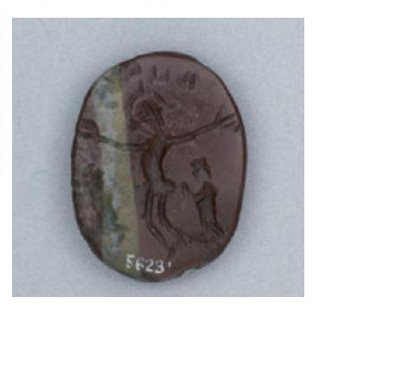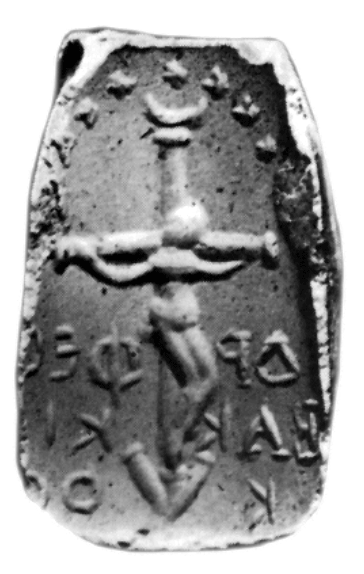I have added some links about the crucifixion gems to my presentation of the "physical evidence of early Christianity."
http://classics.mfab.hu/talismans/cbd/815
https://www.academia.edu/1787622/The_Crucifixion
https://www.academia.edu/1788713/The_Co ... _Antiquity
http://phdiva.blogspot.com/2011/08/earl ... ixion.html
http://books.google.com/books?id=ddCAxg ... em&f=false
http://books.google.com/books?id=BVzVUQ ... em&f=false
http://www.carotta.de/subseite/texte/ar ... kos_en.pdf
http://ifpeakoilwerenoobject.blogspot.c ... art-2.html
http://rogerviklund.wordpress.com/2011/ ... n-english/
http://bedejournal.blogspot.com/2004/07 ... ified.html
http://hypotyposeis.org/weblog/2006/08/ ... image.html
http://hypotyposeis.org/weblog/2006/08/ ... n-gem.html
What are we to make of these?
Crucifixion gems... was orthodoxy late to the party?
- Peter Kirby
- Site Admin
- Posts: 8614
- Joined: Fri Oct 04, 2013 2:13 pm
- Location: Santa Clara
- Contact:
Crucifixion gems... was orthodoxy late to the party?
"... almost every critical biblical position was earlier advanced by skeptics." - Raymond Brown
- Peter Kirby
- Site Admin
- Posts: 8614
- Joined: Fri Oct 04, 2013 2:13 pm
- Location: Santa Clara
- Contact:
Re: Crucifixion gems
Some pics:




Of these three objects, the first appears to have the most secure range of dating (ante-Nicene) and a reference to Jesus Christ (and much besides).



Of these three objects, the first appears to have the most secure range of dating (ante-Nicene) and a reference to Jesus Christ (and much besides).
"... almost every critical biblical position was earlier advanced by skeptics." - Raymond Brown
- Peter Kirby
- Site Admin
- Posts: 8614
- Joined: Fri Oct 04, 2013 2:13 pm
- Location: Santa Clara
- Contact:
Re: Crucifixion gems
I'm just going to go out on a limb here and say this. After reviewing the "physical evidence," and especially if you bracket the literature that was only preserved in a dozen codices hidden in the Egyptian desert (and other modern finds like Codex Tchachos): The ante-Nicene literature preserved by scribes down through the ages appear by weight and volume to be more orthodox than the physical remains do.
The crucifixion gem, even if we discount the Orpheus one, is syncretistic and in the magical tradition. "The string of words contains two names familiar from other magical texts, Badetophoth and Satraperkmeph, the latter of Egyptian derivation, meaning 'Great satrap Kmeph.' Also present, however, is the name Emmanuel (Hebrew for 'God is with us'), taken by Christians to be a reference to Jesus prophesied in Isaiah 7:14 (cf. Matthew 1:23)."
The Abercius inscription has been stretched many ways but by no means excludes a non-Catholic/non-Orthodox author (possibly one of the gnostic or Marcionite varieties). The chief place of Paul might be taken to suggest it.
Dura Europos attests to a place where a harmony reigned instead of the Four Gospels.
The Oxyrhynchus papyri have yielded abundant noncanonical gospel fragments (three of Thomas [1, 654, and 655], POxy 840, POxy 1224, POxy 210, GHebrews [655], GPeter [2949 and 4009], GMary [3525]) and other such stuff (Dialogue of the Savior [1081]). It is little wonder, then, that we also find a fragment of Irenaeus [405], that great late second century heresiologist who seems to have had his hands full with pre-existing error, when the noncanonical texts from the 2nd and 3rd century at Oxyrhynchus seem more numerous than the canonical ones (five fragments of Mt/Mk/Jn/Rm).
The legal papyri and possibly the inscription from Severus show that the orthodox opinion (Tertullian, etc.) that they should not be called "Chrestians" had not exactly gained a lot of traction with the outside world.
The inscriptions in Phyrgia frequently receive attention for possible (and probable) Montanist characteristics.
The earliest Christian inscription, from mid-second century Rome, has been argued to be Christian on the basis of its Valentinian features.
While I titled it "Physical Evidence of Early Christianity," it might with little exaggeration instead be titled "Physical Evidence of So-called Heresy Earlier than Physical Evidence of Orthodoxy."
These remains, as hard to interpret as they may be, represent the only opportunity we really have to check the literature preserved by scribes with an outside control. This control, fairly stated, shows strong evidence for 2nd and 3rd century so-called heresy... but not for the alleged priority of orthodoxy.
The crucifixion gem, even if we discount the Orpheus one, is syncretistic and in the magical tradition. "The string of words contains two names familiar from other magical texts, Badetophoth and Satraperkmeph, the latter of Egyptian derivation, meaning 'Great satrap Kmeph.' Also present, however, is the name Emmanuel (Hebrew for 'God is with us'), taken by Christians to be a reference to Jesus prophesied in Isaiah 7:14 (cf. Matthew 1:23)."
The Abercius inscription has been stretched many ways but by no means excludes a non-Catholic/non-Orthodox author (possibly one of the gnostic or Marcionite varieties). The chief place of Paul might be taken to suggest it.
Dura Europos attests to a place where a harmony reigned instead of the Four Gospels.
The Oxyrhynchus papyri have yielded abundant noncanonical gospel fragments (three of Thomas [1, 654, and 655], POxy 840, POxy 1224, POxy 210, GHebrews [655], GPeter [2949 and 4009], GMary [3525]) and other such stuff (Dialogue of the Savior [1081]). It is little wonder, then, that we also find a fragment of Irenaeus [405], that great late second century heresiologist who seems to have had his hands full with pre-existing error, when the noncanonical texts from the 2nd and 3rd century at Oxyrhynchus seem more numerous than the canonical ones (five fragments of Mt/Mk/Jn/Rm).
The legal papyri and possibly the inscription from Severus show that the orthodox opinion (Tertullian, etc.) that they should not be called "Chrestians" had not exactly gained a lot of traction with the outside world.
The inscriptions in Phyrgia frequently receive attention for possible (and probable) Montanist characteristics.
The earliest Christian inscription, from mid-second century Rome, has been argued to be Christian on the basis of its Valentinian features.
While I titled it "Physical Evidence of Early Christianity," it might with little exaggeration instead be titled "Physical Evidence of So-called Heresy Earlier than Physical Evidence of Orthodoxy."
These remains, as hard to interpret as they may be, represent the only opportunity we really have to check the literature preserved by scribes with an outside control. This control, fairly stated, shows strong evidence for 2nd and 3rd century so-called heresy... but not for the alleged priority of orthodoxy.
"... almost every critical biblical position was earlier advanced by skeptics." - Raymond Brown
-
PhilosopherJay
- Posts: 383
- Joined: Fri Oct 04, 2013 7:02 pm
Re: Crucifixion gems... was orthodoxy late to the party?
Hi Peter,
This is just excellent stuff.
There were probably a number of heterodox Christianities or Chrestianites around in the First and Second Century. The question is when does the Proto-Orthodox Christianity emerge and what was its precise form. The Fourth century Orthodox Christianity of Emperor Constantine seems to have rewritten proto-orthodox Christianity to make it closer to its own image. That is to be expected. Present authority is always looking to past authority to justify its action. The more you can make it seem that what you are doing is nothing new, but is in line with what was done in the past, the better to justify your present actions. My best guess for the emergence of Proto-Orthodox Christianity is the early Third Century. Ireneaus does suggest a Mid-Late Second century date, but it is hard to know how much of Irenaeus has been rewritten to reflect Fourth century Orthodox Christianity. The traces of Proto-Christianity before the Third Century are not enough to convince me that anybody was talking about the father, Son and Holy Ghost in association with Jesus before the Third century.
Warmly,
Jay Raskin
This is just excellent stuff.
There were probably a number of heterodox Christianities or Chrestianites around in the First and Second Century. The question is when does the Proto-Orthodox Christianity emerge and what was its precise form. The Fourth century Orthodox Christianity of Emperor Constantine seems to have rewritten proto-orthodox Christianity to make it closer to its own image. That is to be expected. Present authority is always looking to past authority to justify its action. The more you can make it seem that what you are doing is nothing new, but is in line with what was done in the past, the better to justify your present actions. My best guess for the emergence of Proto-Orthodox Christianity is the early Third Century. Ireneaus does suggest a Mid-Late Second century date, but it is hard to know how much of Irenaeus has been rewritten to reflect Fourth century Orthodox Christianity. The traces of Proto-Christianity before the Third Century are not enough to convince me that anybody was talking about the father, Son and Holy Ghost in association with Jesus before the Third century.
Warmly,
Jay Raskin